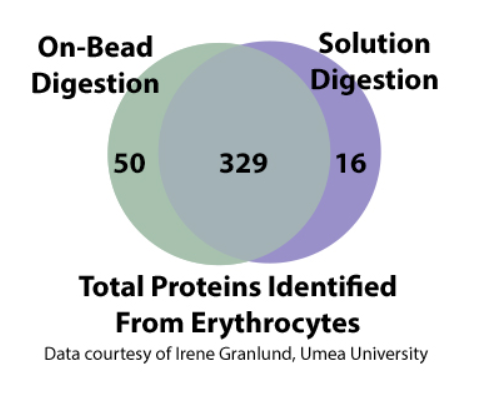Product
제품
- HemoVoid™ LC-MS On-Bead
- 제품명: HemoVoid™ LC-MS On-Bead
- 용도: Hemoglobin Removal with On-Bead Digestion for Proteomics
- 메이커: Biotech Support Group
- 카달로그:
소개
HemoVoid™ LC-MS On-Bead For RBC Proteomics
Hemoglobin depletion plus low abundance protein enrichment
with  optimized on-bead digestion for LC-MS erythrocyte and
optimized on-bead digestion for LC-MS erythrocyte and
whole blood proteomics
• Hemoglobin voids in flow-through >95%, with <30 minute bind/wash
microfuge protocol
• Low abundance enrichment and proteolytic trypsin digestion on the same
bead.
• Consumable, cost-effective, no column regeneration or cross-contamination
• Species agnostic; human, rat, mouse, goat, sheep, porcine and bovine
sera have been tested
• Trypsin digestion on the bead
• Seamless workflows and unique proteolytic efficiencies
- No in-gel digests, no solution digests, no C18 desalting, more consistent,reproducible results
- Compatibility with quantitative label (i.e., iTRAQ) and label-free LC-MS methods
HemoVoid™ LC-MS On-Bead is an hemoglobin depletion and enzymatic proteolytic digestion reagent kit. It removes hemoglobin from serum and plasma samples while concentrating low abundance proteins on the beads. It is ideal for applications involving LC-MS discovery and targeted proteomics.
The HemoVoid™ beads are derived from a silica-based library of individual mixed-mode polymeric ligands. The library was designed to facilitate weak binding of proteins, allowing for progressive enrichment of the low abundance proteome, with specialized voiding properties empirically derived. The HemoVoid™ beads have been adapted to a protocol specifically designed for LC-MS applications whereby the low abundance proteome adsorbed to the bead is proteolytically degraded to its peptide constituents. In this way HemoVoid™ LC-MS On-Bead integrates low abundance enrichment, with Trypsin (or other suitable protease) on-bead digestion, in a simple, highly efficient and seamless workflow for LC-MS discovery and quantitative analyses.
☞
주문정보


관련자료
